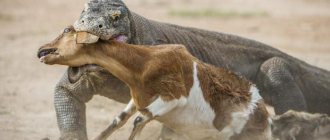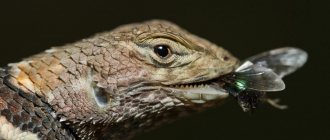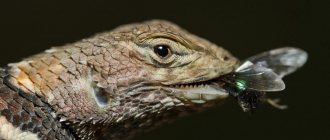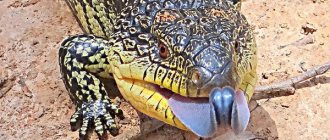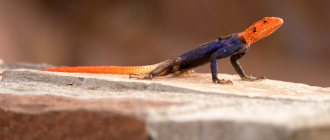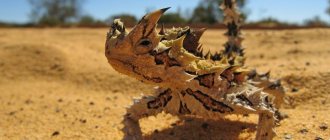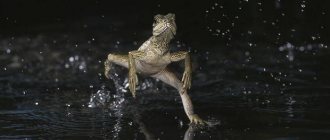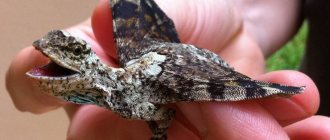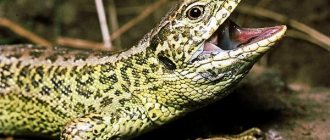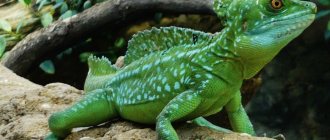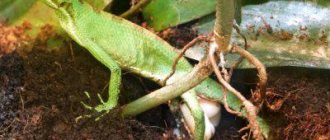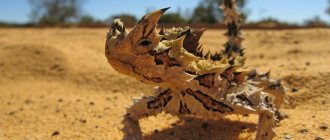In reptile science, there is the concept of “family of true lizards.” This term does not mean that such animals are the most typical representatives of their species. It’s just that this is the family that scientists found and studied first. The green lizard, as this genus of animals is called by scientists, is a representative of the “real” family. This article will provide answers to questions about the habits and habitat of such reptiles.
What do they look like?
The green lizard is a relatively large reptile, whose body length reaches fifteen centimeters. A reptile's tail is usually about twice as long as its body. It is quite fragile, the animal easily throws it off in a moment of danger. There are several scutes on the head of the green lizard. One of them - the premaxillary - reaches the nostril or is separated from it by a bridge. Usually these animals have only one zygomatic shield, while the postnasal ones have two or three. There are also upper labial scutes. They are located in front of the anterior orbital in the number of four, less often - three or five. Between the superior ciliary and supraorbital scutes there are usually up to fourteen grains. It also happens that there are no grains at all. The reptile's head is also equipped with temporal scutes, the upper of which are usually found in number of two, and the middle ones are sometimes more pronounced in size than the rest. The green lizard also has a tympanum, which is sometimes almost invisible. There is a throat fold on the reptile's neck, and there is also a luxurious scaly, impressively jagged collar.
Almost the entire body of the green lizard is covered with scales. The midline of the reptile's throat is decorated with scales, the number of which ranges from 16-27. On the back, the scales of the animal have an elongated hexagonal shape and well-developed ribs. The middle of the reptile's body is framed by 40-58 scales. The anal scute is partially surrounded by six to ten perianal scutes, the middle pair of which is usually wider than the others.
Behavioral features
For most of the time, flying dragons prefer to remain motionless, with the exception of moments when the lizard is trying to catch a victim, while eating, as well as the period of laying eggs and reproducing offspring.
When a lizard sees its prey, it jumps on it and spreads its wings in flight in order to land on nearby trees. These animals can glide over a distance of over twenty meters.
To lay eggs, the female has to climb down from the tree and dig small holes in the ground. Animals do this using their pointed nose. After the female digs a hole, she lays up to four eggs in it and buries them with dirt. As soon as the eggs are buried, the female remains to guard them, and does this for one day and only then returns upstairs.
Nutritional Features
Flying lizards are insectivorous reptiles that feed on termites and ants.
In order to get food, the lizard sits on or near a tree and waits for insects to appear. As soon as the insect appears in close proximity to the reptile, it deftly eats it, without even displacing the animal’s body.
What color are they painted?
It would seem that the answer to this question is hidden in the very name of the animals. However, everything is not so simple. Adults are not at all monochromatic and are often colored in shades of black, yellow and even (in places) blue.
Young lizards are usually single-colored, brownish-brown or brownish-gray with sparse speckles of black, turning into small white spots on the sides. With age, the animal's back turns green, and longitudinal white stripes appear on the sides of the lizard. Adults are dark or bright green in color, dotted with many yellow or black spots on top. Because of them, the lizard sometimes looks almost black with yellow and green splashes. There are reptiles with dark, irregularly shaped spots surrounded by a light edging, located along the ridge. The green lizard has a brownish or emerald head with white or yellow splashes and dashes. During the breeding season, the throat of males becomes bright blue, and that of females - bluish or greenish with marble stains. The belly of the former is bright yellow, the belly of the latter is white.
Domestic lizards
Yemen chameleon
If you think that caring for such a pet is an easy task, we will disappoint you, it is not. Despite the fact that the animal adapts well to “home” conditions, it is not easy to keep it. It is highly susceptible to stress and often gets sick. Constant ventilation in the terrarium is important for the chameleon.
This type of domestic lizard is very beautiful. In young individuals, the body is colored green-light green. As it matures, wide stripes appear on it. The chameleon is known for its ability to change color. It is believed that he does this for the purpose of camouflage. It is wrong. In fact, the color of an animal depends on its mood and status.
In captivity, the female of such a lizard lives no more than 5-6 years, the male a little longer. In the wild, chameleons sit in trees almost all the time. They quench their thirst with morning dew. They can also drink raindrops. They feed on insects.
Three-horned chameleon
It is also called "Jackson's lizard." Keeping such a pet is much easier than keeping a Yemeni chameleon. He is less demanding to care for. This animal, similar to the previous one, is capable of changing color depending on its mood. If it is not under stress, its body will be light green.
Jackson's lizard has 3 horns, one of which, the central one, is the longest and thickest. The reptile has a very strong tail, allowing it to move deftly through trees in the wild. By the way, it is found in Kenya. The three-horned chameleon feeds not only on insects, but also on snails.
Common spiketail
Zoologists nicknamed the reptile this way due to the presence of spike-like processes on its tail. They are only on the outside. The animal lives in Africa and Asia. It is quite large, so it is not easy to keep it at home.
The body length of the spiny tail is up to 75 cm. Brownish-beige and light gray lizards of this species are found. If the animal is frightened, it may attack a person. Spiketail bites at home are a common occurrence.
Australian agama
The habitat of this species is the south and east of Australia. His specialty is his love of water. This became the reason for assigning another name to the reptile “water agama”. The animal prefers to stay near those bodies of water next to which there is vegetation or stones.
It quickly climbs even very tall trees thanks to its tenacious claws and long limbs. But the agama’s thin dorsal fin, which runs through its entire body, allows it to swim in water.
The body weight of the animal is about 800 grams. This species is cautious. If, while on a tree, the agama senses danger, then, without hesitation, she will jump into the water. By the way, she can dive for a minute and a half.
Panther chameleon
This reptile species is endemic to Madagascar. This is a very cute and large lizard, distinguished by its variegated scales. At home, the animal can live up to 5 years. The coloring of individuals is varied. It depends, first of all, on the part of the island in which they live. There are blue, gray-yellow, red-green, light green and other panther chameleons.
The reptile often sits with its long tail curled into a donut shape. Its main food is insects, such as cockroaches or grasshoppers. To prevent the animal's mood from worsening, its owner will have to periodically catch live insects for it.
Fantastic gecko
The best camouflage reptile! By the way, it, like the panther chameleon, is found on the island of Madagascar. If you pay attention to this type of lizard in the photo , where there is foliage, you will hardly be able to see it. It blends almost completely into its environment, which is why some call it the “satanic gecko.”
The tail of the individual is flat, resembling a fallen leaf, the body is uneven, and the brown scales are rough. Despite such unusual parameters and properties for a domestic lizard, it is easy to keep at home. But for her to feel comfortable, there must be a lot of living plants in the terrarium.
frilled lizard
If you want to have a smaller copy of a dragon as a pet, then opt for the frilled lizard. In the wild, even predators avoid it. It's all about a large fold of skin on the neck, which, in case of danger, inflates, changing color. To visually appear larger, the reptile stands on its hind legs.
This sight can scare not only a predator, but even a person. This unusual animal is found on the island of New Guinea. Most often, the gray-brown or bright red body of the individual has light or dark spots. In addition to insects, the frilled lizard is very fond of fruits.
Leopard gecko
Fans of exotic animals will surely like the small but very cute gecko, whose yellow-white scales are covered with black spots, like a leopard. The abdomen of the individual is painted white. In biology, this type of animal is called a “leopard gecko”. It is not difficult to maintain it, the main thing is to create favorable conditions.
The animal lives in desert and rocky areas of Iran, India and Afghanistan. The leopard gecko does not tolerate low temperatures, therefore, in the wild, when winter comes, it falls into torpor. This phenomenon has a scientific name - the pituitary gland.
How does he survive this? It's simple. The supply of fat helps the lizard maintain its viability. The body of a young leopard gecko can reach 25 cm in length. He has a fairly wide tail.
Eyelash banana gecko
The animal lives on some Australian islands. It does not boast a long body or ideal camouflage ability. But this rare species of lizard stands out for its “cilia”. No, they are not the same as those of humans or some mammals. A gecko's eyelashes are small skin projections above the eye sockets. By the way, they are also present along the entire length of the reptile’s back.
These animals cannot be classified as friendly. If you pick it up, it might bite you, but not too much. This is how the lizard tries to protect itself from danger. In addition to banana, she also loves other fruits, such as mango or nectarine.
Green iguana
One of the most beautiful species of lizards . She is large, massive and very dexterous. The green iguana lives in South and North America. Some individuals have small horns on the top of their heads. In the wild, these animals settle near water bodies, next to dense thickets.
During the day they sit mainly in trees. If an iguana senses a predator approaching, it can hide from it by diving into the water. The mass of the lizard is from 6 to 9 kg. The male of this species has a wide crest on his back. Its presence indicates that it has reached sexual maturity.
At home, keeping a green iguana is not easy. She will only feel comfortable in a very large terrarium. If you place two individuals in one small container, a fight may break out between them.
Fire skink
This lizard is very similar to a snake. She has the same wide body and almost the same head shape. Because of its short legs, you might think that the skink does not walk on the ground, but crawls like a viper. The individual can grow up to 35 cm.
This species lives in Africa. He's quite cute. The body of the fire skink has white, brown, red, orange and yellow scales that are in perfect harmony with each other. The lizard stands out for its variegated color.
She loves to dig in the ground, sorting through snags and tree leaves. Therefore, if you want to care for such a pet, make sure that there is a lot of soil and branches in its terrarium.
Blue tongue skink
Another snake-like lizard species. Caring for it is easy and pleasant. Owning blue tongue skinks is recommended for beginners who have not yet kept reptiles at home. There are two reasons. Firstly, the individual is not at all aggressive, and secondly, it has a very interesting appearance.
The blue-tongued skink is an Australian reptile, which nature has endowed with a long tongue of light blue color. Its scales are very smooth, like those of a fish. This is a large animal (up to 50 cm).
When you brought the animal home and placed it in the terrarium, do not rush to pick it up. This can be done only after he has eaten, not earlier, otherwise his acclimatization may be disrupted. As the frequency of tactile contact with the owner increases, the lizard will begin to get used to it.
Black and white tegu
The tegu is found in South America. The animal is distinguished by its impressive dimensions. Under favorable conditions, it can grow up to 1.3 meters. This lizard is classified as a diurnal predator. If you decide to keep a black and white tegu at home, then be prepared for the fact that you will have to feed it live rodents, such as mice.
This is a bloodthirsty animal that slowly kills its prey. In addition to small animals, the lizard feeds on insects. Tegus have a long, thin tongue of a soft pink hue, large eyes and short limbs.
Axolotl (water dragon)
Without a doubt, this is one of the most amazing living creatures in the world. Found in Mexican waters. The water dragon is a salamander that has the amazing ability to regenerate not only its limbs, but also its gills. The color of such lizards is varied. There are pink, purple, gray and other colored individuals.
The axolotl is very similar to a fish. This species has fairly sharp teeth, allowing it to tenaciously hold prey. It feeds not only on live fish, but also on mussels, meat and worms. It is quite complex in content. The water dragon does not tolerate high temperatures. It swims only in cold water, below 22 degrees Celsius.
Where do they live?
The green lizard is found in Southern and Central Europe. She also lives in Asia Minor, its northwestern part. A similar reptile is found almost throughout the entire territory of Moldova and in the southwestern part of Right Bank Ukraine. The area of distribution of the animal in the Dnieper valley reaches Kyiv, in the middle reaches of the river it spreads to the left bank, where it reaches Poltava along the Vorskla River.
The green lizard loves sunny and dry places, often inhabits rocky areas in river floodplains, on hilly slopes with sparse forests and shrubs, in gardens, vineyards, borders, and forest clearings. On average, you can spot one animal per 250-1000 meters of the route. The reptile finds refuge in piles of stones, piles of brushwood, crevices in rocks, spaces under tree trunks lying on the ground, and long specially dug holes.
Paleontological history.
The oldest fossil remains of lizards date back to the Late Jurassic (ca. 160 million years ago). Some of their extinct species were enormous in size. It is believed that Megalania, which lived in Australia in the Pleistocene (approx. 1 million years ago), reached a length of approx. 6 m; and the largest of the mosasaurs (a fossil family of long, slender fish-like aquatic lizards related to monitor lizards) is 11.5 m. Mosasaurs inhabited the coastal sea waters of various parts of the planet for ca. 85 million years ago. The closest modern relative of lizards and snakes is the rather large tuatara, or tuatara, from New Zealand.
What time are they most active?
The green lizard, photographs of which are presented in this article, has different periods of activity in different habitats. In the southern part of Ukraine, the reptile leads a busy lifestyle from March to October, in the middle zone - from May to September. During the hottest period, the animal sometimes goes into summer hibernation. The warm season is marked by a two-vertex peak of activity in the green lizard. In the morning hours she hunts energetically. At noon - from 12.00 to 16.00 - most reptiles disappear into secluded shelters and cool, shaded areas. Then the lizards come out of their hiding places again. During a hunt or sudden danger, animals usually climb trees and bushes, where they easily move from one branch to another, and also jump down from a fairly large height. If the lizard has found a reliable shelter, then it is not easy to lure it out of there. Even hitting the ground hard with a stick will not produce the desired effect.
Relationships with relatives
In general, the character of the lizard is quite friendly, however, during the period of mating or defense of territory, skirmishes often occur between males, in which rivals try to scare each other as much as possible. In the technique of intimidation, the roundhead holds the palm because, in a sense, it can turn into a real little dragon.
To do this, she raises the front part of her body, then spreads her hind legs wide and opens her hissing mouth as much as possible, exposing numerous sharp teeth that are not visible in a calm state. Moreover, the skin folds and mucous membrane at the corners of her mouth take on a bright red hue.
The ominous pose is complemented by sharp movements of the paws and twisting of the tail, after which the rivals violently rush at each other. Such sparring ends with temporary respites or complete surrender of one of the opponents.
The character of the lizard is quite friendly, however, during the period of mating or defense of territory, clashes often occur between males.
What do they eat?
Green lizards are predators. The diet is dominated by spiders, hymenoptera, caterpillars, bugs, orthoptera and beetles. Moreover, gastronomic preferences depend on the time of year. Having woken up from hibernation and for some time after it (in spring and in the first days of summer), reptiles actively eat spiders and beetles. In autumn and in the second half of summer, lizards happily feed on caterpillars and orthoptera. They sometimes supplement their diet with earthworms, mollusks, phalanges, centipedes, dragonflies, dipterans and other insects. Sometimes these animals feed on plant foods, and sometimes they eat smaller lizards.
Features of character and lifestyle
Photo: Common newt from the Red Book
Adult common newts lead both aquatic and terrestrial lifestyles. They have gills and lungs, which allows them to feel comfortable on land and in water. This natural property helps these animals survive during droughts, when the reservoir dries up. In general, the lifestyle of the common newt can be divided into two stages: winter, summer. In winter, the activity of the salamander representative becomes very small. Newts winter on land, looking for shelter for themselves in advance.
Even a simple pile of leaves will be suitable as a shelter for the common newt. But the best option is an abandoned hole. Quite often, newts spend the winter with their relatives. Wintering in a group increases the animals' chances of survival. There may be more than thirty adults in a group. When the ambient temperature drops below zero, newts freeze and stop moving completely.
In spring, even at temperatures below ten degrees Celsius, newts awaken after freezing and return to the water. The water is quite cold at this time, but newts tolerate this temperature well. In summer, common newts are active at night. They do not like bright light and are poorly adapted to heat. During the day you can see such an animal only during rain. Most often, newts live in small flocks, each of which contains about three to four adults.
How do they reproduce?
The large green lizard breeds during the mating season, which lasts from May to June. At this time, fierce battles between males take place. The pregnancy of fertilized females lasts six to eight weeks. After this, in the second half of June and until the end of July, the lizards lay eggs (5-13 pieces), burying them in the soil to a depth of seven to eight centimeters. Young individuals hatch from eggs in late summer and early autumn. As a rule, they lead an independent lifestyle. Sexual maturity in lizards occurs two years after birth.
Lifestyle and habitat
The relict reptile has a slow metabolism, inhalations and exhalations alternate at intervals of 7 seconds. The animal is reluctant to move, but loves to spend time in the water. Hatteria lives on the coast of several small protected island territories of New Zealand, unsuitable for human life.
Half of the total reptile population has settled on Stephens Island, where there are up to 500 individuals per hectare. The landscape consists of rock formations with steep banks, land areas dotted with ravines. Small areas of fertile land are occupied by sparse, unpretentious vegetation. The climate is characterized by high humidity, constant fog, and strong winds.
The beaked tuateria originally lived on the two main New Zealand islands. During the development of lands, colonialists brought dogs, goats, and cats, which each in their own way contributed to the reduction of the reptile population.
When goats grazed, the sparse vegetation was destroyed. Dogs abandoned by their owners hunted tuataria and destroyed nests. Rats caused great damage to the population.
The remoteness and long-term isolation of the territories from the rest of the world have preserved the unique endemic tuataria in its original form. Only there live Hoiho penguins, the kiwi bird and the smallest dolphins. Most of the flora also grows only on the islands of New Zealand.
The territories are favored by numerous colonies of petrels. This proximity is beneficial to the reptile. Reptiles are able to independently dig a hole for housing up to a meter deep, but they prefer to occupy ready-made ones, where birds build nests.
During the day, the reptile is inactive, spends time in shelter, and at night comes out from its shelter in search of food. A secretive lifestyle causes additional difficulties when zoologists study habits. In winter, the tuatteria animal sleeps, but quite sensitively. If the weather is calm and sunny, he goes out to bask on the rocks.
Despite all the clumsiness of movement in a calm state, the reptile runs quite quickly and deftly, sensing danger, or pursuing prey while hunting. More often, the animal does not have to move far, since it waits for the victim, leaning slightly out of the hole.
Having caught a chick or an adult bird, the tuateria tears them into pieces. It grinds individual pieces with worn teeth, moving the lower jaw back and forth.
The reptile feels in the water as if in its element. She spends a lot of time there and, thanks to her anatomical structure, swims well. It does not even neglect puddles formed after heavy rains. Beakheads molt every year. The skin does not come off in a stocking, like that of snakes, but in separate pieces. A lost tail is capable of regeneration.
Nile monitor
Along with the Komodo dragon, the Nile monitor is the largest member of the lizard family. The name of the species is associated with its habitat - the coast of the Nile River, southern Africa and areas adjacent to the Sahara Desert. The reptile is not found in desert areas. The Nile monitor lizard makes its home in the forest, in the savannah, near a swamp. In search of food, it often wanders into fields and even into city streets.
Now the exotic and dangerous lizard can be found in the USA, where someone has released several individuals from domestic captivity. The predators quickly adapted to the new environment and began to reproduce, causing damage to the alligator population—crocodile eggs are a delicacy for them.
The strong, muscular body of the male grows in length up to 1.5-1.7 m, weight ranges from 5 to 10 kg. The female is smaller in size - body length no more than 1.35 m, weight - within 3 kg. About 2/3 of the body is occupied by the tail.
Reference! The length of the largest individual was 2.5 m, weight – 20 kg.
Nile monitor lizards are excellent swimmers, and their body structure is adapted to a long stay in water - the nostrils are higher than those of land lizards, the tail is compressed on the sides, which reduces water resistance.
Nutrition, behavior
The reptile prefers to bask in the sun in the morning, and begins to be active in the afternoon. During periods when it is very hot, it hides from the heat in dug or empty holes of others. Each individual assigns to itself a certain territory, which sometimes intersects with other possessions, but fights do not occur because of this. The female owns a territory whose area is about 15,000 m², and the males have a territory 3-4 times larger.
Fleeing from the pursuit of large predators, lizards run away to a pond and escape underwater, where they can stay for an hour. Any animal that the monitor lizard can handle is suitable for it as food. It can eat carrion, smaller relatives, mollusks, amphibians, birds, crustaceans, and reptile eggs. He is not afraid of snakes, since snake venom does not affect him.
Reproduction
The breeding season coincides with the end of the rainy season. The number of eggs in a clutch depends on the age of the female and her size, so their number varies from 5 to 60 pieces. The female lays the clutch in an old termite mound or digs a hole herself. After 6-9 months, cubs appear from 16 to 30 cm in length. Their appearance coincides with the beginning of the rains, when there is plenty of food for them. They feed on slugs, fish, and various amphibians.
Source
Economic value for humans: Positive
The Arizona borer is of little economic importance to humans. There is a small market for hemipenises, which are used as an aphrodisiac. A “pet” market also exists for this species. This is illegal, however, the animals are kept in captivity. Lizards can be found in many zoos.
Economic significance for humans: Negative
Due to their slow movements, venetian lizards do not pose a threat to humans, however, they have earned a reputation as a dangerous animal that often kills people. Among the Apache Indians, it was believed that its breath could kill a person, and the Tohono-Oodham believed that the poisonous teeth had spiritual powers that could lead to disease.
Nutrition
The diet consists mainly of invertebrate animals. The green lizard eats various large insects and their larvae. Its menu is dominated by beetles, crickets, grasshoppers, dragonflies, butterflies and caterpillars.
To a lesser extent, snails, earthworms, centipedes and arachnids are eaten. Sometimes the predator feasts on small snakes and lizards, including those of its own species. Periodically, the reptile eats small quantities of ripe, juicy fruits and berries.
It detects its potential victim using sight and smell.
The green lizard grabs it with its serrated jaws and swallows it whole. If the hunting trophy turns out to be too large, she chews it several times before swallowing it. Hard wings of insects are first removed.
The main natural enemies are foxes, martens, hedgehogs, domestic cats, birds of prey, aspis vipers (Vipera aspis), lizard snakes (Malpolon monspessulanus) and copperheads (Coronella austriaca). Juveniles are often preyed upon by Common Shrike (Lanius collurio)
Description
The Arizona horned lizard is one of two species of venomous lizards in the world (the other is the Mexican horned lizard or tola hini, (Heloderma horridum)). Vessels are massive and obese lizards with a short tail, in which fat reserves are deposited. The maximum body length of the Arizona horned tooth, including the tail, is 60 centimeters, with the tail making up 20% of the total length. The body is scaly, the color contains yellow, pink and black. The tongue is large and forked at the end. The Vipertooth has a wide head and a pronounced chin. The neck, legs and feet are black. Small black eyes with movable eyelids. The opening of the ear is a narrow, oblique or ovoid slit. The lizard's limbs are strong and equipped with strong claws. Body weight, as a rule, is in the range of 350 – 700 g. The weight of the largest lizard was 2.3 kg.
Literature
- A. G. Bannikov, I. S. Darevsky, A. K. Rustamov
Amphibians and reptiles of the USSR / ed. prof. A. G. Bannikova. - M.: Mysl, 1971. - P. 126-127. — 303 p. - Ananyeva N. B., Orlov N. L., Khalikov R. G., Darevsky I. S., Ryabov S. A., Barabanov A. V.
Atlas of reptiles of Northern Eurasia (taxonomic diversity, geographic distribution and conservation status). - St. Petersburg. : Zoological Institute of the Russian Academy of Sciences, 2004. - P. 108. - 1000 copies. — ISBN 5-98092-007-2
Behavior
The green lizard is diurnal. She sunbathes in the morning and evening, and is most active towards noon. On hot days, it hides underground during lunch hours, appearing on the surface when the temperature begins to subside.
The reptile runs quickly and deftly climbs the trunks of bushes and trees. At the slightest danger, she seeks to escape, hiding in thick grass or under stones. If the escape route is cut off, she tries to scare off the attacker with a hiss or uses sharp teeth, or, in extreme cases, throws away her tail to distract his attention.
The green lizard often uses holes abandoned by other animals. If necessary, she can independently dig an underground shelter up to 1 m deep.
In November, the reptile enters hibernation, which lasts until March or April. Wintering occurs in burrows, under stones or tree roots. Sometimes it overwinters, buried in a thick layer of fallen leaves.
Common iguana
Common iguana
The common green iguana has gained immense popularity as a pet; today representatives of this species can be seen in amateur terrariums around the world. Moreover, she can live without a terrarium, just in the house, moving around its entire area.
However, the nature of the reptile is not so flexible, and many of its owners ended up with numerous and difficult to treat wounds. The iguana is excellent at biting and fighting with its claws if it senses danger or is simply not in the mood. The weight of a large individual reaches 7 kg with a height of 1.5 meters, which makes its attack a truly serious circumstance. Is it worth having such exotic pets at home? You should think about this several times before buying an iguana.
